Riyadh Metro Surpasses 18 Million Riders in Just Two Months in 2025
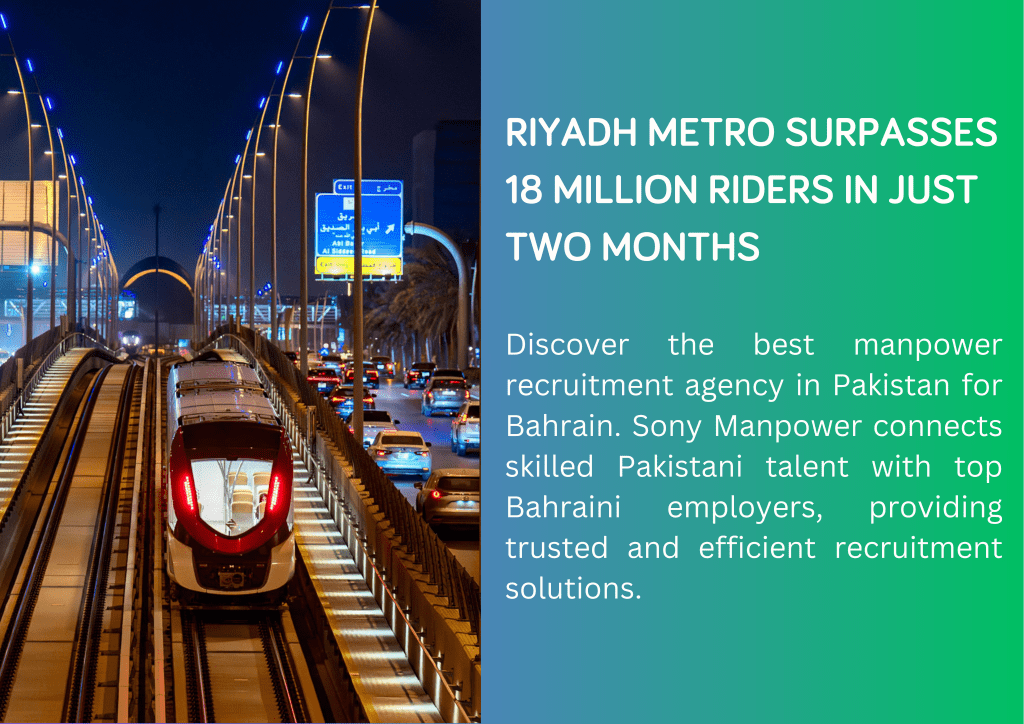
Riyadh Metro Surpasses 18 Million Riders in Just Two Months in 2025 The Riyadh Metro has made an incredible start in transforming the way people travel around Saudi Arabia’s capital. In its first two months of operation, over 18 million passengers have used the metro, according to the Royal Commission for Riyadh City. This remarkable milestone shows how quickly the metro is becoming a key part of everyday life for residents and visitors in Riyadh. A New Era of Public Transport in Riyadh Riyadh, one of the largest and fastest-growing cities in the Middle East, has long struggled with traffic congestion and pollution. The launch of the Riyadh Metro aims to tackle these issues head-on by offering a modern, efficient, and sustainable alternative to car travel. The six-line metro network, which covers a massive 176 kilometers, is designed to connect various parts of the city and ease the traffic burden. Since its launch, the metro system has already completed more than 162,000 trips and traveled a total of over 4.5 million kilometers. With 85 stations located at strategic points across the city, the metro has provided a convenient and fast way for people to move around. This is especially important in a city like Riyadh, where traffic jams are a common occurrence. The Blue Line: The Most Popular Line The Blue Line, which runs parallel to Olaya Street, has proven to be the busiest so far. It alone has carried nearly 10 million passengers within the first two months. Olaya Street is one of Riyadh’s most important commercial and business areas, meaning this line is highly significant for residents and people visiting the area for work or leisure. The Blue Line’s popularity highlights the need for efficient public transportation systems in high-traffic areas. As more people rely on public transit instead of driving, the metro helps to alleviate congestion in some of the city’s busiest districts. King Abdullah Financial District (KAFD) Station: A Hotspot The King Abdullah Financial District (KAFD) station has emerged as the most popular metro stop. With over 3 million passengers passing through it already, this station is vital for commuters traveling to and from the financial hub of Riyadh. The KAFD station is also unique because it was designed by the world-renowned architect Zaha Hadid. The station’s stunning architecture stands out, making it not only a major transit point but also a work of art that adds to the beauty of the city’s skyline. Eco-Friendly and Sustainable Transportation One of the main goals of the Riyadh Metro is to contribute to the city’s sustainability. The metro is designed to reduce carbon emissions by encouraging people to use public transportation instead of driving private cars. This is particularly important in a city like Riyadh, where air pollution has been a growing concern. By reducing the number of cars on the road, the metro is helping to improve air quality and reduce the city’s carbon footprint. Moreover, the metro features driverless trains, making it more energy-efficient and modern. The air-conditioned cabins provide passengers with a comfortable ride, even during Riyadh’s hot summers. With its clean, energy-efficient technology, the Riyadh Metro is in line with Saudi Arabia’s Vision 2030, which aims to transform the country’s infrastructure, reduce its dependence on fossil fuels, and promote sustainability. Seamless Integration with Riyadh’s Public Transport Another key feature of the Riyadh Metro is its integration with the Riyadh Bus system. This allows passengers to switch easily between different modes of public transport, making it simpler to navigate the city. Whether you’re traveling by metro, bus, or even bike, Riyadh’s public transport network is designed to provide smooth and efficient connections across the city. Passengers can plan their trips using the Darb app, a mobile application that helps people track routes, schedules, and even manage payments. The app allows riders to stay up to date with the latest information on metro operations. It also makes the ticketing process seamless, as riders can use contactless payments to board the trains. This convenience helps to encourage more people to use public transport instead of relying on their cars. A Transportation System Built for the Future With a daily capacity of 3.6 million riders, the Riyadh Metro is set to play a huge role in shaping the future of the city. As the population of Riyadh continues to grow, the metro will provide a sustainable solution to meet the increasing demand for public transportation. The metro’s extensive network also helps ensure that people in different parts of the city have easy access to fast and reliable transport. The Riyadh Metro is not just a public transport system; it is part of a larger vision for the city’s future. It is a model of modern urban planning, focused on improving the quality of life for the people of Riyadh while making the city more sustainable and eco-friendly. Metro Stations: Architectural Marvels Beyond its functionality, the Riyadh Metro system also contributes to the architectural landscape of the city. The metro’s stations are designed to be modern, visually appealing, and futuristic. Some stations, like the KAFD Metro Station, have gained international attention due to their unique and cutting-edge designs. The architecture of the Riyadh Metro stations has been carefully planned to reflect the city’s growth and modernity. The stations combine practicality with stunning design, making the metro an integral part of the city’s identity. The metro is helping Riyadh develop into a world-class city with infrastructure that can compete with major global capitals. The Future of Riyadh Metro: Expansion Plans The metro system is still in its early stages, but there are already plans for further expansion. As the network continues to grow, it will provide even more connections, covering more parts of the city and eventually extending to other areas of the Kingdom. With each new line and station, the Riyadh Metro will further cement its role as a key driver of urban mobility in Saudi Arabia. It will help reduce traffic congestion, lower emissions, and make commuting more convenient for everyone. Key Facts About Riyadh Metro: 18 million passengers in just 2 months. 162,000 trips completed. Over 4.5 million kilometers traveled. 85
Saudi Arabia Sets 10th Ramadan as Final Date for Hajj
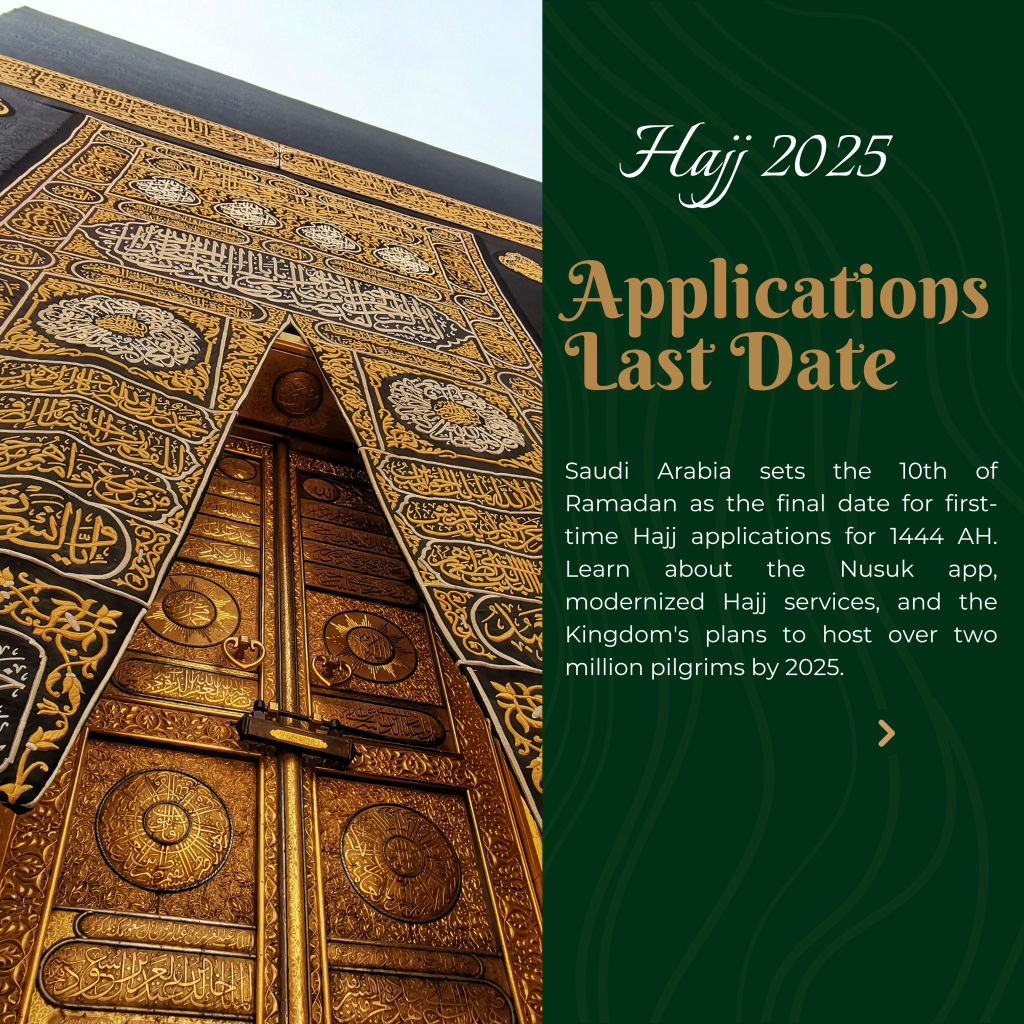
Saudi Arabia Sets 10th Ramadan as Final Date for Hajj Applications for First-Time Pilgrims In a recent announcement, the Saudi Ministry of Hajj and Umrah revealed that the 10th of Ramadan will serve as the final deadline for domestic pilgrims, including citizens and residents of Saudi Arabia who have never performed Hajj before, to submit their applications for the upcoming Hajj season of 2025. This decision is part of the Kingdom’s efforts to streamline the Hajj application process and ensure that first-time pilgrims are given priority in securing their spots for the annual Islamic pilgrimage. For those who have previously performed Hajj, the rules are slightly different. Citizens and residents who last performed Hajj five or more years ago will be eligible to submit their applications after the 10th of Ramadan. This distinction ensures that both first-time pilgrims and those seeking to perform Hajj again after a significant gap are accommodated in an organized manner. The Ministry has encouraged all eligible individuals to submit their Hajj requests through the official Hajj website for domestic pilgrims or via the Nusuk app, which has been designed to simplify the application process. These digital platforms are part of Saudi Arabia’s broader initiative to modernize and digitize Hajj-related services, making it easier for pilgrims to register, book, and pay for their pilgrimage online. Nusuk App: A Gateway for International Pilgrims In addition to catering to domestic pilgrims, the Nusuk platform has been expanded to serve international pilgrims from over 58 countries, including regions such as Europe, the United States, Australia, and others. The app provides a seamless and user-friendly experience, allowing pilgrims to complete their registration, book services, and make payments online. Through Nusuk, pilgrims can also select from a variety of service packages tailored to their needs, including accommodation, food services, flights, transportation, and assistance during their stay in Saudi Arabia. The introduction of the Nusuk app reflects Saudi Arabia’s commitment to enhancing the overall Hajj experience for pilgrims worldwide. By digitizing the process, the Kingdom aims to reduce the logistical challenges often associated with Hajj and ensure that pilgrims can focus on the spiritual aspects of their journey. Preparations for Hosting Two Million Pilgrims Saudi Arabia is gearing up to welcome approximately two million pilgrims during the Hajj season of 2025, according to Tawfiq Al-Rabiah, the Minister of Hajj and Umrah. This marks a significant milestone as the Kingdom continues to recover from the impact of the COVID-19 pandemic, which led to a drastic reduction in the number of pilgrims allowed to perform Hajj in recent years. By 2025, the Kingdom aims to host over two million pilgrims, reflecting a full recovery and even surpassing previous attendance figures. This resurgence is a testament to the Kingdom’s robust health measures, advanced infrastructure, and commitment to ensuring a safe and spiritually fulfilling experience for all pilgrims. The Ministry of Hajj and Umrah has been working tirelessly to ensure that all necessary arrangements are in place to accommodate the expected influx of pilgrims. This includes upgrading infrastructure, enhancing transportation networks, and implementing advanced health and safety protocols to safeguard the well-being of pilgrims. The Kingdom’s efforts are aligned with its Vision 2030 goals, which aim to position Saudi Arabia as a global leader in religious tourism and hospitality. Prioritizing First-Time Pilgrims The decision to set the 10th of Ramadan as the final date for first-time pilgrims underscores Saudi Arabia’s commitment to ensuring that those who have never performed Hajj are allowed to fulfill this important Islamic obligation. Hajj is one of the five pillars of Islam and is considered a once-in-a-lifetime duty for every able-bodied Muslim who can afford it. By prioritizing first-time pilgrims, the Kingdom is helping to ensure that more Muslims around the world can experience the spiritual journey of Hajj. For those who have performed Hajj before, the opportunity to apply after the 10th of Ramadan provides a chance to revisit the holy sites and renew their faith. The five-year gap requirement ensures that the limited spaces available for Hajj are distributed fairly among those who have not recently performed the pilgrimage. A Modernized Hajj Experience The introduction of digital platforms like the Nusuk app and the Hajj website for domestic pilgrims is a testament to Saudi Arabia’s efforts to modernize the Hajj experience. These tools not only simplify the application process but also provide pilgrims with greater flexibility and control over their travel arrangements. By offering a range of service packages, pilgrims can customize their Hajj journey to suit their preferences and budgets. Moreover, the use of technology in managing Hajj operations has significantly improved efficiency and transparency. Pilgrims can now track their applications, receive real-time updates, and access important information through these platforms. This digital transformation is part of Saudi Arabia’s broader strategy to enhance the overall quality of services provided to pilgrims and ensure a smooth and hassle-free experience. A Message of Inclusivity and Accessibility Saudi Arabia’s efforts to accommodate both domestic and international pilgrims reflect its commitment to inclusivity and accessibility. By leveraging technology and implementing fair policies, the Kingdom is ensuring that Hajj remains accessible to Muslims from all walks of life. The emphasis on first-time pilgrims, coupled with the streamlined application process, demonstrates Saudi Arabia’s dedication to upholding the spiritual significance of Hajj while adapting to the needs of the modern world. As the Hajj season of 2025 approaches, the Kingdom continues to work diligently to prepare for the arrival of millions of pilgrims. From upgrading infrastructure to implementing advanced health measures, Saudi Arabia is leaving no stone unturned in its efforts to provide a safe, comfortable, and spiritually enriching Hajj experience for all. Final Words: In conclusion, the announcement of the 10th of Ramadan as the final date for first-time pilgrims to submit their Hajj applications marks an important step in Saudi Arabia’s ongoing efforts to modernize and streamline the Hajj process. With the introduction of digital platforms like the Nusuk app and the commitment to hosting two million pilgrims, the Kingdom is setting a new standard for religious
Saudi Arabia Expands Umrah Access to All Visa Holders
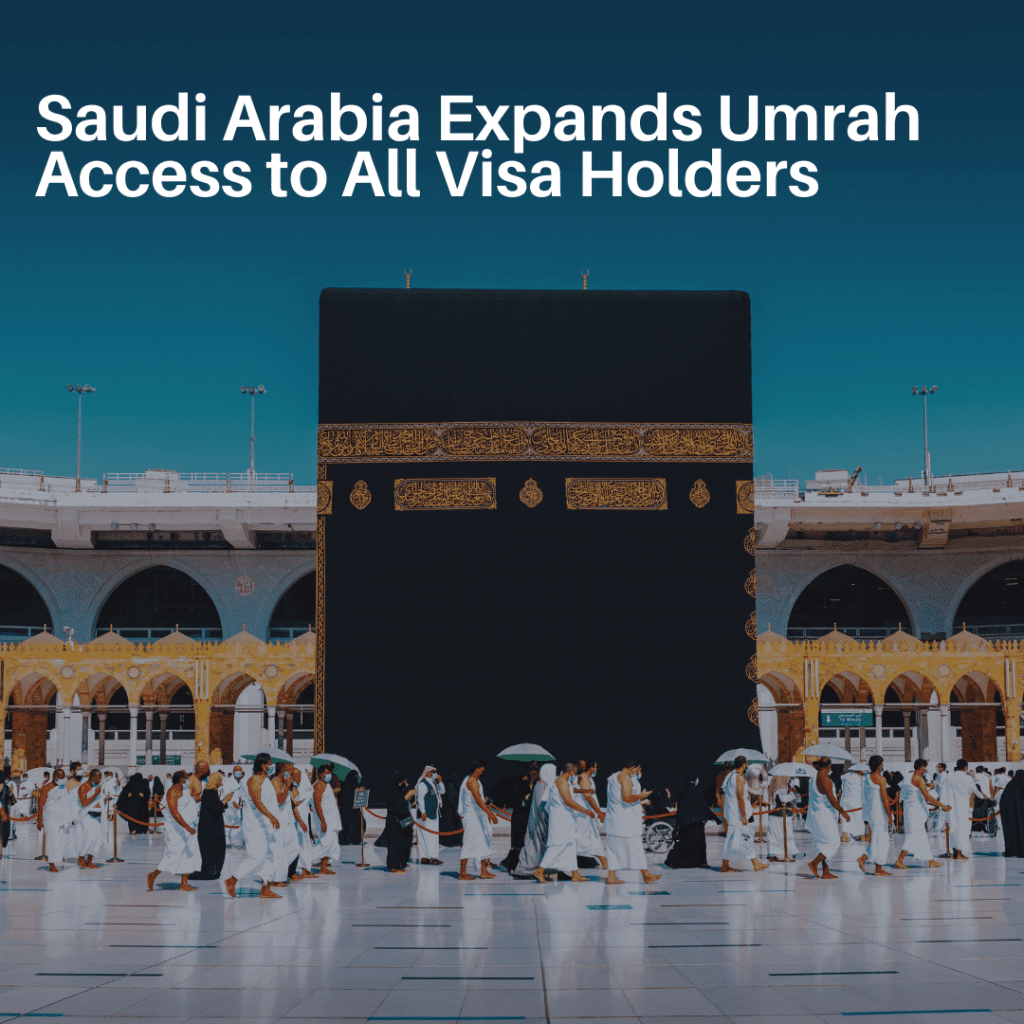
Saudi Arabia Expands Umrah Access to All Visa Holders In a groundbreaking move, Saudi Arabia has announced that all visa holders can now perform Umrah, making the sacred pilgrimage more accessible to millions of Muslims worldwide. This significant update, announced by the Ministry of Hajj and Umrah, is part of the Kingdom’s ongoing efforts to streamline religious tourism and align with its ambitious Saudi Vision 2030 initiative. Under the new guidelines, travelers no longer need a specialized Umrah visa to perform the pilgrimage. Instead, anyone with a valid entry visa—whether for tourism, business, or other purposes—can now undertake Umrah, provided they obtain a permit through the Nusuk app. This change marks a major shift in Saudi Arabia’s approach to religious tourism, emphasizing inclusivity and ease of access for pilgrims from around the globe. What is Umrah? Umrah is a spiritual pilgrimage to the holy city of Makkah, often referred to as the “lesser pilgrimage” compared to Hajj. While Hajj is obligatory for all able-bodied Muslims who can afford it and is performed during specific dates in the Islamic month of Dhul-Hijjah, Umrah can be undertaken at any time of the year. It is not mandatory in Islam but holds immense spiritual significance, offering Muslims an opportunity for reflection, repentance, and renewal of faith. The rituals of Umrah include entering a state of purity (Ihram), performing Tawaf (circumambulating the Kaaba), Sa’i (walking between the hills of Safa and Marwa), and shaving or trimming the hair. These acts symbolize devotion, humility, and unity among Muslims. Key Highlights of the Umrah Visa Update The latest update by the Ministry of Hajj and Umrah introduces several transformative changes to the Umrah process: The Role of the Nusuk App The Nusuk has become an essential tool for pilgrims, offering a seamless and user-friendly experience. Key features of the app include: By digitizing the permit process and centralizing services, the Nusuk app reflects Saudi Arabia’s commitment to leveraging technology for the convenience of pilgrims. Impact on Pilgrims Worldwide This update is a game-changer for Muslims around the world, particularly those who may have faced challenges in obtaining a specialized Umrah visa. By allowing all visa holders to perform Umrah, Saudi Arabia is opening its doors to a broader audience, fostering inclusivity and unity among the global Muslim community. For example, business travelers, expatriates, and tourists visiting Saudi Arabia can now easily incorporate Umrah into their trips without the need for additional visas or complex procedures. This flexibility is expected to increase the number of Umrah pilgrims, boosting religious tourism and contributing to the Kingdom’s economy. Alignment with Saudi Vision 2030 The expansion of Umrah access is a key component of Saudi Vision 2030, a strategic framework aimed at diversifying the Kingdom’s economy and reducing its dependence on oil. By enhancing the pilgrimage experience and making it more accessible, Saudi Arabia aims to attract millions of visitors annually, positioning itself as a global hub for religious and cultural tourism. This initiative also reflects the Kingdom’s commitment to modernizing its infrastructure and services while preserving the spiritual essence of Hajj and Umrah. From state-of-the-art transportation systems to world-class hospitality, Saudi Arabia is investing heavily to ensure that pilgrims have a comfortable and memorable experience. A Message of Inclusivity and Unity The Ministry of Hajj and Umrah has emphasized that this update is part of Saudi Arabia’s broader mission to welcome people from all walks of life to experience the spiritual resonance of Umrah. In a tweet announcing the change, the Ministry stated: “Visitors can effortlessly perform Umrah from any location and with any entry visa, ensuring ease and peace of mind. #Makkah_and_Madinah_Eagerly_Await_You.” This message underscores the Kingdom’s dedication to fostering a sense of unity and belonging among Muslims worldwide, regardless of their nationality or background. How to Prepare for Umrah Under the New Rules If you’re planning to perform Umrah under the new guidelines, here’s a step-by-step guide to help you prepare: Final Words: Saudi Arabia’s decision to expand Umrah access to all visa holders is a monumental step toward making the pilgrimage more inclusive and accessible. By removing barriers and leveraging technology, the Kingdom is not only enhancing the experience for pilgrims but also reinforcing its position as a global leader in religious tourism. This update is a testament to Saudi Arabia’s commitment to innovation, inclusivity, and the preservation of Islamic heritage. As the doors to Makkah and Madinah open wider, millions of Muslims around the world now have the opportunity to embark on this spiritual journey with greater ease and flexibility. Whether you’re a first-time pilgrim or a seasoned traveler, the new Umrah rules offer a chance to connect with your faith meaningfully. As the Ministry of Hajj and Umrah aptly puts it, “Makkah and Madinah eagerly await you.”
Gulf Cities Among the Safest in the World – Report 2025
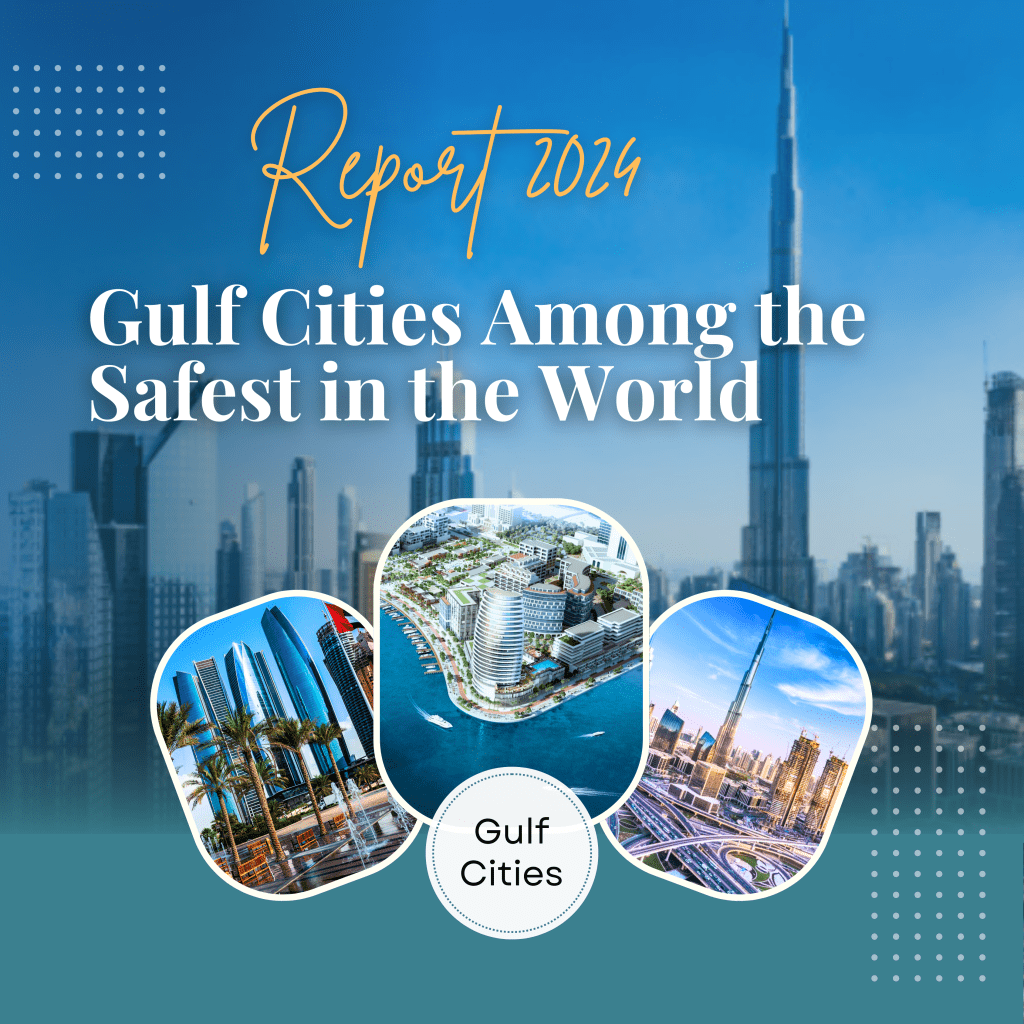
Gulf Cities Among the Safest in the World – Report 2024 The Gulf region continues to be recognized for its safety and security, as highlighted in Number’s latest Safety Index for 2024. Cities in the UAE, Qatar, and Oman have ranked among the world’s safest, with Abu Dhabi securing the top position once again. These rankings emphasize the strong law enforcement, public safety measures, and quality of life that define urban living in the Gulf. Gulf Cities Lead the Safety Index Rankings Numbeo, a global database that evaluates urban living conditions, has released its 2024 Safety Index. This index assesses various cities worldwide based on crime rates, security measures, and overall safety. The latest report shows that Gulf cities continue to dominate the top positions, reinforcing their reputation for offering secure environments for residents, expatriates, and tourists. Top 10 Safest Cities in 2024 The Numbeo rankings for 2024 list the following cities as the safest in the world: These rankings highlight the commitment of Gulf countries to public safety, strong governance, and efficient law enforcement strategies. With five UAE cities in the top ten, it’s clear that the country prioritizes security and stability. Abu Dhabi: The World’s Safest City For the eighth consecutive year, Abu Dhabi has ranked as the safest city globally. The UAE capital achieved an impressive Safety Index score of 88.1, reflecting its minimal crime rates and strong public security. The city’s crime index is remarkably low at 11.94, indicating that residents feel safe during both day and night. Why is Abu Dhabi the Safest City? Several factors contribute to Abu Dhabi’s position as the world’s safest city: The city’s low crime rates, efficient urban planning, and strong legal framework make it an ideal place to live, work, and visit. Muscat: A Safe and Thriving Capital Oman’s capital, Muscat, has been recognized as one of the safest cities globally, ranking eighth in Number’s Safety Index with a score of 81.1. The city is known for its peaceful environment, low crime rates, and high standards of living. Why Muscat is Among the Safest Cities Beyond safety, Muscat is also undergoing significant development. The government is focusing on tourism, infrastructure, and economic growth, making it an attractive city for both investors and visitors. Doha: Qatar’s Secure and Stable Capital Doha, the capital of Qatar, ranks as the seventh safest city in the world, with a Safety Index of 83.7. The city’s strict laws, modern infrastructure, and strong police presence contribute to its high ranking. Reasons for Doha’s High Safety Ranking With ongoing developments, Doha is set to become a major global hub for business, tourism, and expatriates. Dubai: A Safe and Dynamic Metropolis Dubai, ranked third on the list with a Safety Index of 83.9, is not only one of the safest cities but also one of the most advanced. The city’s commitment to safety, combined with its economic opportunities, makes it a preferred destination for expatriates and tourists. Factors Behind Dubai’s Safety Dubai’s combination of safety, business opportunities, and luxury living attracts millions of visitors every year. Gulf Region’s Commitment to Safety The high rankings of Gulf cities in the Number’s Safety Index reflect the region’s dedication to public security, economic stability, and urban development. The UAE, Qatar, and Oman have invested significantly in law enforcement, surveillance systems, and infrastructure to ensure a high quality of life for their residents. Key Reasons for Gulf Cities’ High Safety Rankings With these consistent rankings, Gulf cities are not only providing safe living environments but are also becoming prime destinations for global investment and tourism. Final Words: Numbeo’s 2024 Safety Index confirms that Gulf cities are among the safest in the world. With Abu Dhabi leading the rankings, followed by Ajman, Dubai, Sharjah, Ras Al-Khaimah, Doha, and Muscat, the region continues to set high standards for urban safety and security. These rankings reflect the Gulf’s commitment to law enforcement, technological advancements, and sustainable urban development. As these cities continue to grow, they offer a secure and thriving environment for residents, businesses, and visitors alike. Whether for tourism, business, or living, Gulf cities remain among the top choices for safety and quality of life.
Saudi Arabia Cities by Population 2025
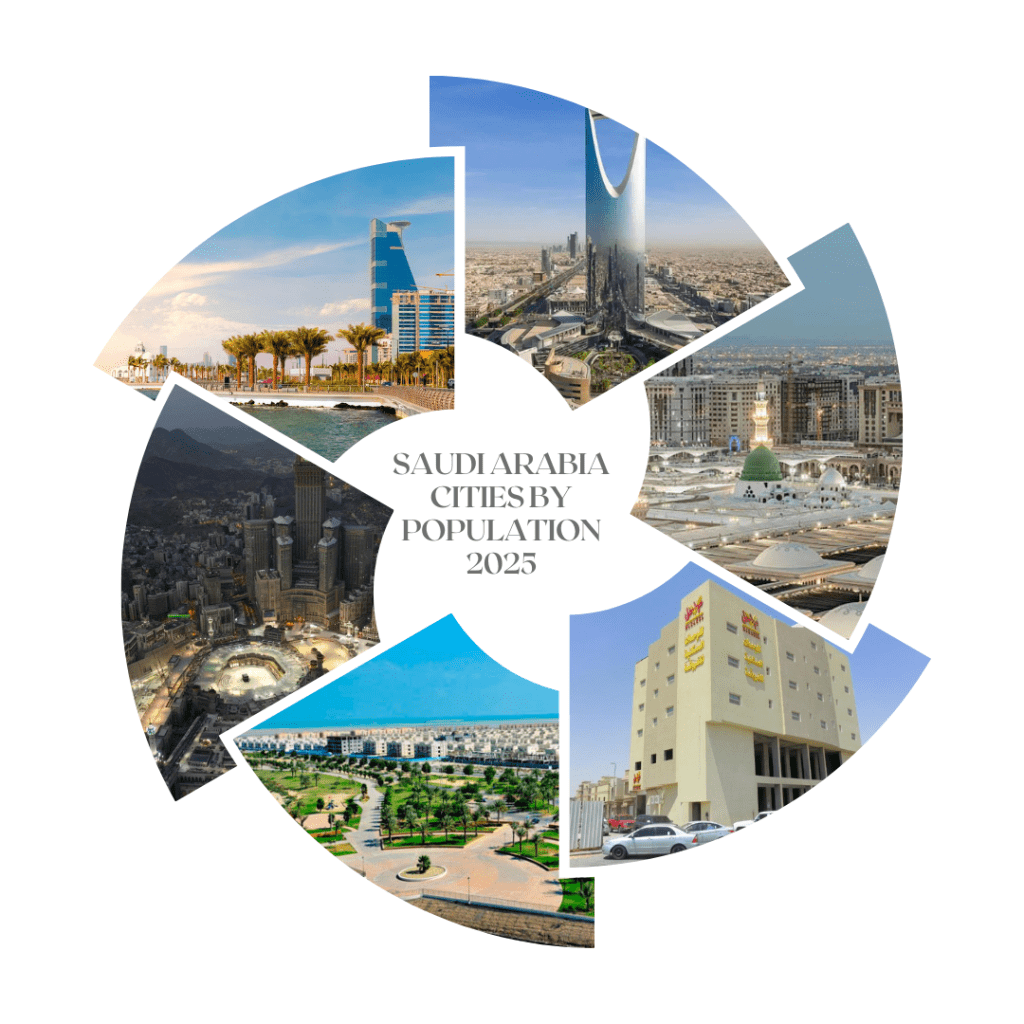
Saudi Arabia Cities by Population 2025 Saudi Arabia, the largest country in the Middle East, has experienced significant population growth over the decades. As of 2025, its population is estimated to be 34,566,328, with major cities like Riyadh, Jeddah, Mecca, and Medina leading in urban density. This blog provides a detailed overview of Saudi Arabia’s cities by population in 2025, along with a historical analysis of the country’s population growth, migration trends, fertility rates, and urbanization. Saudi Arabia’s Most Populated Cities in 2025 Saudi Arabia is home to many growing urban centers. Below is a table of the most populated cities in Saudi Arabia in 2025: City Estimated Population (2025) Riyadh 7,953,000 Jeddah 5,022,000 Mecca 2,219,000 Medina 1,625,000 Dammam 1,376,000 Hufuf-Mubarraz 897,000 Buraydah 741,000 Taif 726,000 Jubail 712,000 Tabuk 707,000 1. Riyadh – The Capital and Largest City Riyadh is the most populous city in Saudi Arabia with an estimated 7.95 million people in 2025. As the capital, it serves as the political, economic, and cultural hub of the nation. The city’s growth is fueled by job opportunities, migration, and urban development. 2. Jeddah – The Commercial Hub Jeddah, with a population of 5.02 million, is the second-largest city and Saudi Arabia’s primary commercial center. It is home to King Abdulaziz Port, one of the busiest ports in the region, and serves as a gateway for Hajj and Umrah pilgrims. 3. Mecca – The Holiest City in Islam Mecca has an estimated 2.21 million residents in 2025. Millions of Muslims visit this city annually for Hajj and Umrah, which significantly boosts its population during pilgrimage seasons. 4. Medina – The Second Holiest City Medina’s population is expected to reach 1.62 million in 2025. It is known for Al-Masjid an-Nabawi, the Prophet Muhammad’s mosque, attracting millions of visitors every year. 5. Dammam – The Industrial and Oil Hub Dammam, with 1.37 million residents, is a major industrial and petroleum city located in the Eastern Province. It has a thriving economy due to its oil production and trade links. Saudi Arabia’s Population Growth (1955 – 2025) Saudi Arabia’s population has grown rapidly over the decades, fueled by economic expansion, urbanization, and migration. Below is a historical overview of Saudi Arabia’s population growth: Year Population Yearly % Change Yearly Growth 2025 34,566,328 1.78% 603,571 2024 33,962,757 2.10% 698,465 2023 33,264,292 3.38% 1,088,940 2022 32,175,352 2.70% 846,977 2020 30,991,207 1.70% 518,396 2015 29,974,938 3.57% 963,562 2010 25,157,128 4.12% 919,448 2005 20,559,890 4.91% 876,434 2000 16,177,722 4.01% 577,695 1990 10,640,691 5.47% 497,782 1980 6,047,997 5.83% 298,342 1970 3,562,470 4.00% 126,740 1960 2,435,403 3.69% 80,690 Key Observations from Historical Population Growth Factors Influencing Saudi Arabia’s Population Growth 1. Migration and Expatriate Workforce Saudi Arabia is home to millions of expatriates working in various industries. In 2025, the net migration is estimated at 119,738 people. The country relies on foreign workers, especially in construction, oil, hospitality, and domestic services. 2. Fertility Rate and Birth Rate The fertility rate in Saudi Arabia has decreased over the years: This decline is due to modernization, improved healthcare, women’s education, and workforce participation. 3. Urbanization and Population Density Saudi Arabia is becoming increasingly urbanized: Urban Development and Future Projections 1. Vision 2030 and Smart Cities Saudi Arabia’s Vision 2030 aims to: 2. Economic Diversification The government is investing in: These initiatives will attract more foreign investment, businesses, and workers, influencing future population trends. Final Words: Saudi Arabia’s population in 2025 is projected to be 34.56 million, with Riyadh, Jeddah, and Mecca being the largest cities. The country has experienced rapid population growth, fueled by urbanization, migration, and economic development. However, trends such as a declining fertility rate, economic diversification, and urban expansion will shape its demographic future. Saudi Arabia’s commitment to Vision 2030, smart cities, and sustainable development will continue to impact population growth and distribution in the coming decades. Similar Links: Cities In Saudi Arabia List Details – 2025
Top In-Demand Jobs in Saudi Arabia (2025) – Sony Manpower Consultant

Top In-Demand Jobs in Saudi Arabia (2025) – Sony Manpower Consultant Saudi Arabia is rapidly growing, creating many job opportunities across different industries. With Vision 2030 initiatives, the demand for skilled professionals is increasing. If you are looking for a job in Saudi Arabia, it is important to understand which jobs are in high demand and what skills employers are looking for. 5 Highly Demanded Skills in Saudi Arabia Before discussing specific job roles, here are some key skills that can help you secure a job in Saudi Arabia. These skills are required in various fields and will improve your chances of getting hired. 1. Digital Marketing Businesses in Saudi Arabia are focusing on building their online presence. Skills like Search Engine Optimization (SEO), social media marketing, email marketing, and content creation are highly valued. 2. Data Analysis The ability to collect, analyze, and visualize data is crucial for decision-making. Skills like SQL, Microsoft Excel, and data modeling are important for many industries. 3. Project Management With many infrastructure and business projects in progress, companies need professionals who can manage teams, ensure smooth workflows, and complete projects on time. 4. Customer Service Good customer service is essential for businesses to build trust and retain clients. Strong communication skills, cultural awareness, and patience are important. 5. Languages English is a must for professional jobs in Saudi Arabia. If you know multiple languages, you have an advantage, especially in customer service and business roles. Top 10 In-Demand Jobs in Saudi Arabia (2025) If you are planning to work in Saudi Arabia, here are the top 10 jobs that offer great career opportunities. 1. Digital Marketing Specialist Salary: SAR 9,500-35,000 per month Hiring Companies: Ogilvy, Leo Burnett, MullenLowe Why This Job? Every business needs an online presence, and digital marketing experts help them grow online. Skills Needed: SEO, social media marketing, content creation, Google Analytics 2. Data Analyst / Data Scientist Salary: SAR 8,000-25,000 per month Hiring Companies: SAP, Oracle, SAS Institute Why This Job? Saudi Arabia is focusing on data-driven decision-making. Experts who can analyze and present data are in high demand. Skills Needed: SQL, machine learning, Python, R, statistical analysis 3. Software Developer Salary: SAR 7,500-22,000 per month Hiring Companies: STC, Elm, Ureed Why This Job? Saudi Arabia’s tech industry is expanding, creating a need for skilled software developers. Skills Needed: Java, JavaScript, C#, full-stack development 4. Civil Engineer Salary: SAR 8,000-30,000 per month Hiring Companies: Saudi Binladin Group, Al Arrab Contracting Co. Ltd. Why This Job? Saudi Arabia is investing in major construction projects for infrastructure and tourism. Skills Needed: Structural analysis, AutoCAD, project budgeting 5. Teacher / Education Specialist Salary: SAR 6,000-20,000 per month Hiring Companies: GEMS Education, Taibah Schools, Kingdom Schools Why This Job? Saudi Arabia aims to improve its education system, creating more teaching opportunities. Skills Needed: Lesson planning, classroom management, student engagement 6. Nursing Professional Salary: SAR 5,500-15,000 per month Hiring Companies: Dr. Sulaiman Al Habib Medical Group, Saudi German Hospital Group Why This Job? The demand for healthcare professionals is rising due to an aging population and increasing health awareness. Skills Needed: Patient care, medication administration, infection control 7. Accounting & Audit Professional Salary: SAR 7,000-20,000 per month Hiring Companies: KPMG, PwC, Deloitte Why This Job? Saudi companies need financial experts for auditing, budgeting, and compliance. Skills Needed: IFRS, GAAP, risk management, financial modeling 8. Human Resources (HR) Manager Salary: SAR 9,000-25,000 per month Hiring Companies: Al Rajhi Bank, SABIC, STC Why This Job? Skilled HR professionals are needed to manage recruitment and employee relations in growing companies. Skills Needed: Recruitment, compensation planning, HR analytics 9. Social Media Manager Salary: SAR 6,000-18,000 per month Hiring Companies: STARZPLAY, Careem, Noon Why This Job? Saudi Arabia has high social media usage, and businesses need experts to manage their online presence. Skills Needed: Content creation, influencer partnerships, social media analytics 10. Business Development Manager Salary: SAR 8,000-22,000 per month Hiring Companies: Abdul Latif Jameel, Almarai, Savola Group Why This Job? Companies in Saudi Arabia are expanding, requiring professionals who can build partnerships and increase sales. Skills Needed: Lead generation, financial analysis, negotiation How to Find a Job in Saudi Arabia? If you want to work in Saudi Arabia, follow these job search strategies to increase your chances of success. Build a Strong Network – Connect with professionals on LinkedIn and join job-related groups. Research Companies – Understand employer expectations and tailor your resume accordingly. Get Certified – Certifications can make you stand out from other candidates. Use Online Job Portals – Websites like LinkedIn, Bayt.com, and GulfTalent are useful for job searches. Ensure Your Resume is Well-Written – Use tools like Qureos’ resume builder to create a professional resume. Create a Portfolio – Showcase your skills, projects, and experience. Prepare for Tests – Some companies conduct skill assessment tests during hiring. Showcase Work Samples – If applicable, provide samples of previous work, such as reports, designs, or content. Final Words: Saudi Arabia is offering great job opportunities in fields like technology, healthcare, education, and business. With Vision 2030 initiatives, over 1 million new jobs are expected to be created. If you have the right skills and follow the right job search strategies, you can secure a rewarding career in Saudi Arabia. For recruitment services and job placement assistance, Sony Manpower Consultant is here to help. Contact us today to explore job opportunities in Saudi Arabia! More Similar Links: Top Recruitment Agencies in pakistan For Saudi Arabia
Cities In Saudi Arabia List Details – 2025
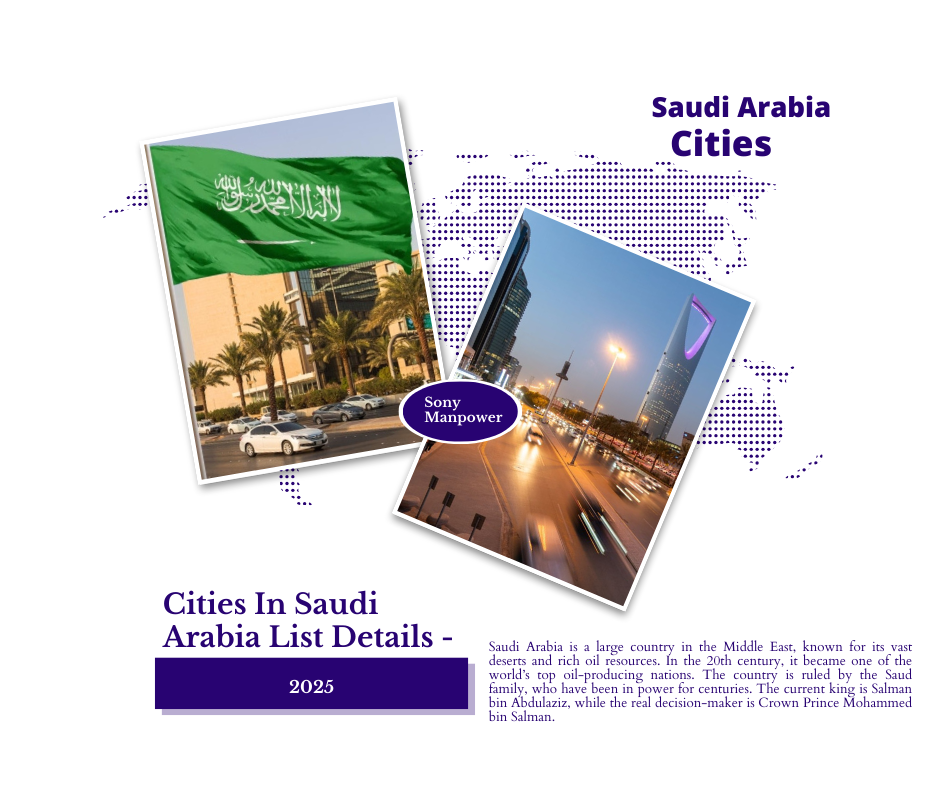
Cities In Saudi Arabia List Details – 2025 Saudi Arabia is a large country in the Middle East, known for its vast deserts and rich oil resources. In the 20th century, it became one of the world’s top oil-producing nations. The country is ruled by the Saud family, who have been in power for centuries. The current king is Salman bin Abdulaziz, while the real decision-maker is Crown Prince Mohammed bin Salman. Geography and History Saudi Arabia covers most of the northern and central Arabian Peninsula. It is a young country with a long and deep-rooted history. The western part, known as Hejaz, is home to Islam’s two holiest cities—Mecca and Medina. The central region, Najd, is a vast desert that was once mainly inhabited by nomadic tribes. The eastern side, near the Persian Gulf, is where most of the country’s oil fields are located. These three factors—Islam, tribal culture, and oil wealth—have shaped the country’s history. Government and Population Government Type: Monarchy King: Salman bin Abdulaziz Crown Prince & Prime Minister: Mohammed bin Salman Capital City: Riyadh Population (2025 Estimate): 34.3 million Currency: Saudi Riyal (1 SAR = 74.41 PKR, 0.27 USD) Development and Change Saudi Arabia became a modern nation in the early 20th century when the Saud family unified different regions. Their power was strengthened by their alliance with Wahhabism, a strict form of Islam. Over the years, the country has grown rapidly due to its massive oil revenues. While many citizens have benefited from this wealth, there have also been concerns about how the money is managed. Some people believe the government spends too much on luxury rather than public welfare. In the past, Saudi Arabia was mostly a desert land with small towns and villages. But with oil wealth, the country developed quickly. Cities like Riyadh, Jeddah, and Dammam grew into modern urban centers. Many Saudis now work in offices, businesses, and industries instead of traditional farming or trading. The country also employs millions of foreign workers. Technology and transportation have advanced significantly. Highways, airports, and modern communication systems connect Saudi Arabia to the world. Many young Saudis study abroad, mainly in the United States. Television, radio, and the internet have become common sources of education and information. List Of Cities In Saudi Arabia Saudi Arabia is home to many cities, each with its unique significance. Some of the major cities include: Riyadh – The capital and largest city Jeddah – A major port and commercial hub Mecca – Islam’s holiest city, visited by millions of pilgrims every year Medina – The second holiest city in Islam Dammam – An important oil and industrial city Tabuk – A city in the northwest, known for its historical sites Al-Khobar – A modern city in the Eastern Province Yanbuʿ – An important industrial city on the Red Sea Buraydah – A city known for agriculture Najran – A historical city in the south Abhā – A scenic city known for its cool climate and mountains Abqaiq – A small but vital city for oil production Al-Baḥah – A city with a pleasant climate and beautiful landscapes Al-Hufūf – A historic city in the Eastern Province Al-Jawf – Famous for its ancient sites and agriculture Al-Kharj (oasis) – Known for its natural springs and farming Al-Qaṭīf – One of the oldest settlements in the region Al-Ṭaʾif – Famous for its cool weather and rose gardens ʿArʿar – A northern city near the Iraq border Dhahran – A key center for Saudi Arabia’s oil industry Ḥāʾil – A city with a rich cultural heritage Jīzān – A port city known for agriculture and trade Khamīs Mushayt – A growing urban center in the southwest King Khalīd Military City – A military base and residential city Ras Tanura – Home to one of the largest oil refineries in the world Sakākā – A city known for its historical ruins Saudi Arabia continues to grow and modernize while preserving its deep cultural and religious traditions. Here’s a detailed explanation of all the major cities in Saudi Arabia: 1. Riyadh Significance: Riyadh is the capital and largest city of Saudi Arabia. It serves as the political, financial, and administrative hub of the country. The city is home to government offices, multinational companies, and modern skyscrapers like the Kingdom Centre and Al Faisaliah Tower. Riyadh is known for its rapid development, luxury shopping malls, and historical sites like Masmak Fortress. 2. Jeddah Significance: Jeddah is the commercial hub and the largest port city of Saudi Arabia, located on the Red Sea coast. It is the gateway for millions of pilgrims traveling to Mecca for Hajj and Umrah. The city is famous for its Corniche (seafront area), King Fahd Fountain (the world’s tallest fountain), and historic Al-Balad district. 3. Mecca (Makkah) Significance: Mecca is Islam’s holiest city and home to the Kaaba, located inside Masjid al-Haram (The Grand Mosque). Every year, millions of Muslims visit Mecca to perform Hajj and Umrah. Non-Muslims are not allowed to enter the city. 4. Medina (Madinah) Significance: Medina is the second holiest city in Islam, where Masjid an-Nabawi (the Prophet’s Mosque) is located. It is the burial place of Prophet Muhammad (PBUH). The city is a major religious and historical site and is known for its peaceful atmosphere. 5. Dammam Significance: Dammam is an important oil and industrial city in the Eastern Province. It is the administrative capital of the Eastern Province and a center for oil refining, business, and trade. The city has modern infrastructure, shopping malls, and a beautiful coastline along the Persian Gulf. 6. Tabuk Significance: Tabuk is a northwestern city known for its historical sites and military bases. It was an important location during the time of Prophet Muhammad (PBUH). Today, it is a growing city with a developing tourism sector, offering natural landscapes, mountains, and historical forts. 7. Al-Khobar Significance: Al-Khobar is a modern city in the Eastern Province known for its beaches, shopping centers, and expatriate community. It is connected to Bahrain via the King Fahd Causeway. The city is a popular leisure and business destination. 8. Yanbuʿ Significance: Yanbuʿ is an industrial city on the Red Sea coast with a major oil refinery and petrochemical plants. It is divided into Yanbu Industrial City, Yanbu Al-Bahr (old town), and Yanbu Al-Nakheel (rural areas). It also serves as a port for trade and shipping. 9. Buraydah Significance: Buraydah is known for agriculture, especially date farming. It hosts the largest date festival in the world. Located in the Qassim region, it is an important economic and cultural center in central Saudi Arabia. 10. Najran Significance: Najran is a historical city
STC KSA APN Settings for Android & iPhone: Easy Guide 2025

STC KSA APN Settings for Android & iPhone: Easy Guide 2025 Would you be able to configure your STC internet settings? This guide provides step-by-step instructions on how to set up your STC KSA APN settings easily. If you are experiencing issues with your data connection or noticing a slow internet speed, updating your default STC APN settings can significantly improve your device’s connectivity for faster browsing. STC (Saudi Telecom Company) is a leading telecom provider in Saudi Arabia, offering 4G and 5G internet services to over 2.5 million subscribers. Despite its popularity, many users face confusion when it comes to configuring their internet settings. This article offers a detailed guide on setting up your STC internet manually or through SMS and Call, ensuring a seamless internet experience. Follow the instructions below to optimize your connection today. STC Access Points Here’s a simple guide to manually configure or edit your STC internet APN settings for free: Open Mobile Settings on your device. Navigate to Wireless & Networks. Select Mobile Networks and then click on Access Point Names. Tap the Menu button and choose New APN. Follow these steps to ensure your internet settings are correctly configured for a smooth browsing experience. STC APN Internet Settings Code To configure your STC internet settings via SMS, follow these steps: Type “JawalNet“ in a new SMS. Send the message to 2222. Save the settings received via SMS. Enter the PIN code: 1234 when prompted. This method ensures quick and hassle-free internet configuration. STC Saudi Arabia Internet APN Settings Setting Name Details Name STC-Saudi-Arabia-INTERNET APN Jawalnet.com.sa Proxy Not set Port Not set Username Not set Password Blank Server Blank MMSC Blank MMS Proxy Not set MMS Port Not set MCC 420 MNC 01 Authentication Type None APN Type Default APN Protocol IPv4 APN Roaming Protocol IPv4 APN Enable/Disable APN Enabled Bearer Unspecified MVNO Type Not set MVNO Value Blank Mobile Virtual Network Operator Type None Mobile Virtual Network Operator Value Blank Note: The above settings also apply to STC 4G routers for seamless connectivity. STC KSA APN Setting for Android Follow the steps; go to ‘Mobile Settings,’ click ‘Wireless & Networks’, Then select ‘Mobile Networks,’ click ‘Access Point Names,’ Press the ‘Menu button,’ Now select ‘New APN.’ Name STC-Saudi-Arabia-INTERNET APN Jawalnet.com.sa Proxy Not set Port Not set Username Blank Passwords Blank Server Blank MMSC Not set MMS proxy Not set MMS port Blank MCC 420 MNC 01 Authentication type Not set APN type default APN protocol IPv4 APN roaming Protocol IPv4 STC 4G KSA APN Setting for iOS To configure STC APN settings on your iOS device, follow these steps: Open iPhone Settings. Tap Cellular and then Cellular Data Network. Select APN Settings. Enter the following details: Field Details Name STC-Saudi-Arabia-INTERNET APN Jawalnet.com.sa Username Not set Password Not set Save the settings, and your iPhone will be ready to connect to STC’s 4G network. STC MMS Settings To configure MMS settings for STC, use the details below: Field Value APN Jawalnet.com.sa Username Leave blank Password Leave blank MMSC Not set MMS Proxy 10.1.1.1:8080 MMS Message Size 1 MB (1048576 bytes) MMS UA Prof URL Not set Ensure these settings are saved to enable MMS functionality on your device. STC KSA MMS Settings To configure MMS settings for STC KSA on your device, follow the steps below and use the provided details: Open Mobile Settings: Access your phone’s settings menu. Navigate to APN Settings: Go to Mobile Networks > Access Point Names (APN). Create a New APN: Tap the Menu button and select New APN. Enter the MMS Settings: Fill in the following fields: Field Details Name MMS Setting APN mms.net.sa Proxy Not set Port Not set Username Leave blank Password Leave blank Server Leave blank MMSC Not set MMS Proxy 10.1.1.1 MMS Port 8080 MCC 420 MNC 01 Authentication Type Not set APN Type mms APN Protocol IPv4 APN Roaming Protocol IPv4 Save and Activate: Save the settings and select this APN as your active profile. These settings ensure that MMS features are properly configured for STC’s network. More Resources: Transfer Money from STC to Pakistan, India and Philippines Stc To Stc Balance Transfer In Easy Method – 2024 Method to Check STC Balance in Saudi Arabia
Method to Check Your Mobily SIM Number in KSA in 2025

How to Check Your Mobily Sim Number In KSA If you’re using a Mobily SIM in Saudi Arabia and need to find your phone number, don’t worry—it’s easy! Here are five simple methods to help you check your Mobily SIM number. 1. Dial a USSD Code The quickest way to find your Mobily SIM number is by dialing a code: Open your phone’s dialer. Enter *222# and press the call button. Your Mobily SIM number will instantly appear on your screen. 2. Send an SMS You can also use the messaging feature on your phone to get your number. Open the messaging app. Create a new message and type the number ‘1.’ Send it to 1411. You’ll receive a reply with your SIM details, including the phone number, SIM owner’s name, and activation date. 3. Call Mobily Customer Care If you prefer speaking to someone, you can call Mobily’s helpline for assistance. Dial 1100 from your Mobily SIM. Provide your name, ID, or Iqama number when asked. The customer service representative will give you your Mobily number. 4. Use the “Please Call Me” Service Here’s another simple way to figure out your number: Dial *1888# on your phone. Enter your friend’s number when prompted. Your friend will receive a text that includes your Mobily number. 5. Check Through the Mobily App or Website If you’re tech-savvy, you can use the Mobily app or website to find your SIM number: Download the Mobily app from your app store. Log in to your account and check your SIM details. Alternatively, visit the official Mobily website for the same information. Important Notes Using the USSD code to check your number is free. For any additional details, you can always call Mobily customer care. Customer service can also help you verify the SIM owner’s name, registered address, and location. Mobily may update its codes, so make sure you have the latest information. These simple steps will help you find your Mobily SIM number quickly! If you still have questions, don’t hesitate to contact Mobily’s helpline for support. More Links: Transfer Mobily Balance to Pakistan, Philippines, and India How to Check Mobily Balance in Saudi Arabia: Complete Guide
Booking Your Islamabad to Jeddah Flight in 2025

Booking Your Islamabad to Jeddah Flight in 2025 To make your trip from Islamabad to Jeddah smooth and affordable, you can easily book your flights online through various platforms like ours. We provide the latest information on flight availability, prices, schedules, and updates for the Islamabad to Jeddah route. Whether you are traveling for religious purposes, tourism, or business, we offer a range of options to suit your budget and schedule. By booking early, you ensure the best prices, especially with high demand around Ramadan. Keep in mind that flight prices can fluctuate based on the time of booking and the season, so it’s advisable to secure your tickets as early as possible to get the most affordable rates. Direct and Indirect Flights from Islamabad to Jeddah Many airlines operate direct and connecting flights from Islamabad to Jeddah. Direct flights are usually quicker, taking approximately 5 hours and 40 minutes, while indirect flights may have layovers in major cities such as Dubai, Abu Dhabi, Istanbul, Doha, or Muscat. These indirect flights can extend the total travel time, sometimes up to 20 hours, depending on the length of the layover. Some airlines, like PIA and SAUDI Airlines, offer nonstop flights, while others like Emirates, Turkish Airlines, Qatar Airways, and Etihad Airways provide flights with stopovers. When booking, it’s essential to consider the total duration of your journey and layover times to select the best option that fits your preferences. Top Airlines Operating Islamabad to Jeddah Flights PIA (Pakistan International Airlines): Offers both direct and indirect flights, with competitive pricing starting from around PKR 102,736. PIA is the national carrier and provides comfortable services, making it a popular choice for many travelers. SAUDI AIRLINE: Known for its affordable fares and excellent service, SAUDI AIRLINE offers both direct and indirect flights from Islamabad to Jeddah. It is often considered one of the best options for pilgrims traveling for Umrah. Emirates: Offers flights with a layover in Dubai, typically taking about 10 hours in total. Emirates is renowned for its premium service, making it a popular choice for travelers willing to spend a little more for added comfort. Qatar Airways: Known for its exceptional service and comfort, Qatar Airways operates flights with a layover in Doha. The total duration of the flight can be around 12-15 hours, depending on the layover. Etihad Airways: This airline provides flights with a stop in Abu Dhabi. The total flight time is around 9 hours and 5 minutes, and Etihad is known for its top-tier service. Turkish Airlines: Turkish Airlines operates flights with a stop in Istanbul. Although these flights can be longer, Turkish Airlines is highly praised for its excellent customer service. Flynas: For budget-conscious travelers, Flynas offers some of the most economical tickets, with a stopover in Riyadh. Oman Air: With a layover in Muscat, Oman Air offers good value for money with flight durations of around 10 hours. AirBlue: A Pakistani airline offering both direct and indirect flights. Airblue is known for competitive pricing and comfortable services. Choosing the Right Flight The best flight option for you will depend on factors such as your budget, preferred flight duration, and your flexibility with layovers. For direct flights, PIA and SAUDIA offer the most straightforward options. If you’re looking for a balance between price and comfort, Emirates and Qatar Airways provide excellent services with reasonable stopovers. For the most affordable options, Flynas and AirBlue can offer lower fares. If you are traveling during peak seasons like Ramadan or Hajj, it’s crucial to book your flights well in advance, as prices tend to rise and availability can become limited. Other Travel Tips for Islamabad to Jeddah By carefully planning and booking your Islamabad to Jeddah flight well in advance, you can secure a seat on your preferred airline at the best price. Be sure to stay updated on any travel restrictions or changes, especially around the peak travel seasons of Ramadan or Hajj. Visit Sony Manpower for more information, flight bookings, and the best deals for your trip from Islamabad to Jeddah!


